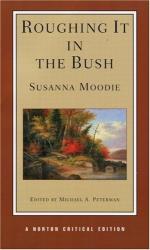On the night of the second day of his fast another child died of the fever. He had now to accomplish three more days without tasting food. It was too much even for an Indian. On the evening of the fourth, he was so pressed by ravenous hunger, that he stole into the woods, caught a bull-frog, and devoured it alive. He imagined himself alone; but one of his people, suspecting his intention, had followed him, unperceived, to the bush. The act he had just committed was a hideous crime in their eyes, and in a few minutes the camp was in an uproar. The chief fled for protection to Young’s house. When the hunter demanded the cause of his alarm, he gave for answer, “There are plenty of flies at my house. To avoid their stings I came to you.”
It required all the eloquence of Mr. Young, who enjoyed much popularity among them, to reconcile the rebellious tribe to their chief.
They are very skilful in their treatment of wounds, and many diseases. Their knowledge of the medicinal qualities of their plants and herbs is very great. They make excellent poultices from the bark of the bass and the slippery elm. They use several native plants in their dyeing of baskets and porcupine quills. The inner bark of the swamp-alder, simply boiled in water, makes a beautiful red. From the root of the black briony they obtain a fine salve for sores, and extract a rich yellow dye. The inner bark of the root of the sumach, roasted, and reduced to powder, is a good remedy for the ague; a teaspoonful given between the hot and cold fit. They scrape the fine white powder from the large fungus that grows upon the bark of the pine into whiskey, and take it for violent pains in the stomach. The taste of this powder strongly reminded me of quinine.
I have read much of the excellence of Indian cookery, but I never could bring myself to taste anything prepared in their dirty wigwams. I remember being highly amused in watching the preparation of a mess, which might have been called the Indian hotch-potch. It consisted of a strange mixture of fish, flesh, and fowl, all boiled together in the same vessel. Ducks, partridges, muskinonge, venison, and muskrats, formed a part of this delectable compound. These were literally smothered in onions, potatoes, and turnips, which they had procured from me. They very hospitably offered me a dishful of the odious mixture, which the odour of the muskrats rendered everything but savoury; but I declined, simply stating that I was not hungry. My little boy tasted it, but quickly left the camp to conceal the effect it produced upon him.
Their method of broiling fish, however, is excellent. They take a fish, just fresh out of the water, cut out the entrails, and, without removing the scales, wash it clean, dry it in a cloth, or in grass, and cover it all over with clear hot ashes. When the flesh will part from the bone, they draw it out of the ashes, strip off the skin, and it is fit for the table of the most fastidious epicure.




